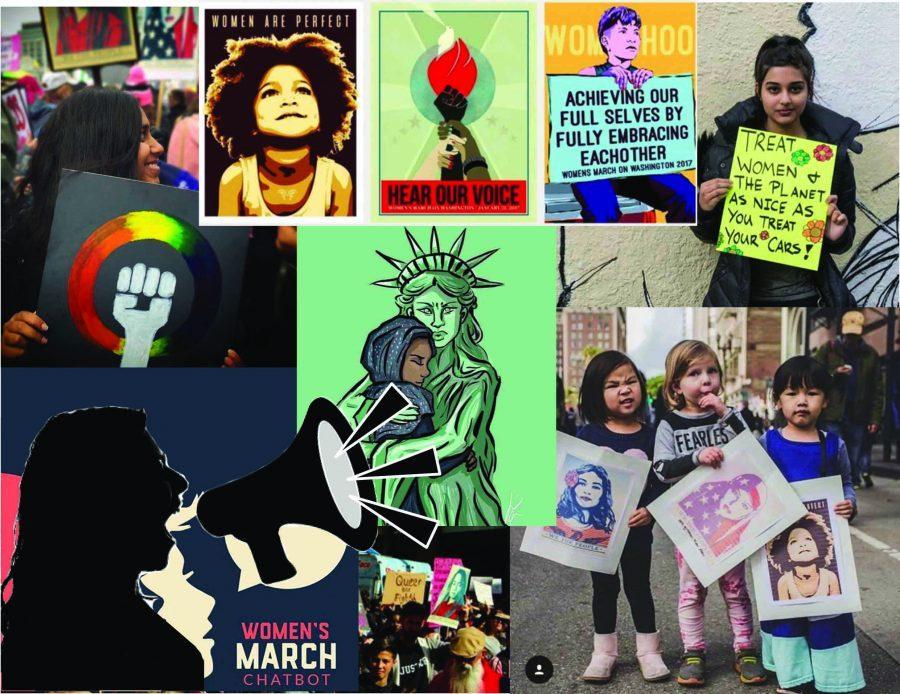Planned parenthood, pussyhats and the patriarchy
The Women’s March advocates nationwide action
March 8, 2017
In the largest day of protest in U.S. history, a sea of half a million heads punctuated by signs and pink cat-eared hats gathered in Washington, D.C. for the Women’s March on Jan. 21, 2017 as millions of other gathered worldwide to protest a multitude of issues plaguing the nation.
Although the real march took place in Washington D.C., people on all seven continents participated in sister marches, totaling roughly five million people. In the U.S, the number broke down to 50,000 in Austin, 120,000 in Seattle, 250,000 in Chicago, 400,000 in New York City and a whopping 750,000 demonstrators in Los Angeles to name a few cities.
The march, which took place a day after President Donald Trump’s inauguration, sought to change more than just the protection of women’s rights.
Senior Tanya Mahadwar, who was in San Francisco for a college interview on the day of the march with her mother and grandmother, listened to some of the event’s speakers and joined the crowd in protest.
“I went to that march for a lot of different reasons. I think the biggest one to me was that I was pretty unhappy with the outcome of the election and I think my mom and my grandma, who have both seen so much systemic injustice happen to them throughout their lives…I think this was the first real time we could go someplace and experience the unhappiness that we felt.”
Although President Trump’s election inspired the march itself, the march focused on more than just displeasure at the election results.
The diverse crowd brought in a tangle of brewing issues they wanted to address. Protesters raised their voices to ask about issues such as climate change and LGBT+ rights and their concerns for the future of these issues in light of President Trump’s inauguration. It was a symposium of thought, spurned on by immense concern.
“I’ve never actually gone to a march like that before, so I’d always wanted to see what that was about. I was thinking, ‘What better way to do that than go to a march that’s supposed to be inclusive and includes people of all different spectrums and all different backgrounds and sexual orientations and genders?’ … I’d never seen something more inclusive in my life before and to me and it was just pretty awesome that they made it a point that everyone felt included.” Mahadwar added.
Many marchers also celebrated the lack of police and protester conflict: the march had no arrests. Instead, police — some clad in pink hats themselves — posed for selfies and monitored the crowd. This contrasted heavily with Inauguration Day, where bands of anti-Trump groups smashed store windows and lit a limousine on fire, leading to 200 arrests. The notable lack of violence on the day of the march was chalked up as a success for peaceful resistance, one of the largest in modern history.
“I was just proud of the fact that people were really peaceful. Everyone was very kind to each other,” Mahadwar recalled. “People were sharing umbrellas with each other.”
In fact, much of the march centered around the theme best summarized by the hashtag “Love Trumps Hate”.
In an effort to turn the President’s words against him, protesters used the president’s own infamous statements against him.
In fact, President Trump’s quote, “Grab them by the p****”, led to the creation of “pussyhats”. The pink cat-eared hats became popularized by the Women’s March, as various citizens and celebrities both rocked the hat. The Pussyhat Project, founded by Krista Suh and Jayna Zweiman, led to the knitting of over 60,000 hats by Dec. 2016.
Another soundbite of Trump, “Such a nasty woman”, was a common motif throughout the protests, prominently featured on a variety of posters and signs.
“I think it’s a bold message to the Trump administration,” sophomore Vishruti Ganesh said. “[The demonstrators] were trying to send Trump a message that there’s a whole bunch of people who aren’t happy with his election … He needs to make people feel like he’s president for everyone and not just the people who voted for him.”
However, the movement doesn’t stop there. To continue their resistance, the Women’s March has provided its own call-to-action following the march. On their official website, a 100-day action plan has been launched. Every 10 days, a new action will be promoted to encourage people to speak out for change they want to see. The first action pushed for people to send a postcard to their local senators, while the second action organized “huddles” for people to meet and discuss ideas.
“One thing that’s very important for people at our age is to understand we do have a say in the way that this government is going and if we have problems with it it’s important to contact local lawmakers and to speak out,” Mahadwar said in her closing statement. “It’s important to get your message out there to really enact change.”
To read about or contribute to the march’s ongoing effort, visit www.womensmarch.com.


